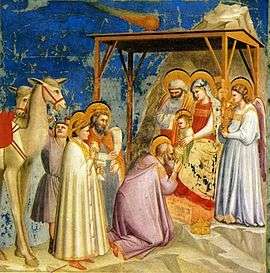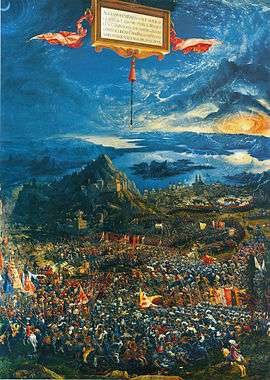Astronomical art
Astronomical art is the aspect of Space art devoted to visualizing the wonders of outer space. A major emphasis of such art is the space environment as a new frontier for Humanity. Many other works portray alien worlds, extremes of matter such as black holes, and concepts arising from inspiration derived from astronomy.
Astronomical art was largely pioneered in the 1940s and 50s by the abilities of Chesley Bonestell to solve formidable perspective problems, paint with the eye of a master matte artist to create a realistic visual impression, and to seek out the greatest experts in the fields which fascinated him. His work helped inspire many in the post war era to think about space travel, which seemed fantastic before the V-2 rocket. To this day numerous artists assist in bringing ideas into presentable form in the space community, both in portraying the latest ideas on how to leave Earth and in showing wonders awaiting us out there.
Astronomical Art is the most recent of several art movements which have explored the inspirational ideas emerging from ongoing exploration of Earth, (Hudson River school, or Luminism) the distant past, (ancient history and prehistoric animal art) and finally the steadily revealed universe. Most Astronomical artists use traditional painting methods or digital equivalents in a way which brings the viewer to the frontiers of human knowledge gathered in the exploration of space. Such works usually portray things in the familiar visual language of realism extrapolated to exotic environments whose details reflect ongoing knowledge and educated guesswork. An example of the process of creating astronomical art would be studying and visiting desert environments to experience something of what it might be like on Mars, and painting based on such experience. Another would be to hear of something likely to be amazing to watch close up, then seeking out published articles or experts in the field. Usually there is an artistic effort to emphasize the favorable visual elements just as a photographer composes a picture. The best astronomical art shares with the viewer what it is that catches the artists imagination about the subject portrayed.
Science Fiction magazines such as Fantasy and Science Fiction, Amazing, Astounding (later renamed Analog), and Galaxy served as a major outlet for the work of space and particularly astronomical artists in the 1950s. The several picture essay magazines of the time such as Life, Collier's, and Coronet were other major outlets for such art. Today astronomical art can be seen in magazines such as Sky and Telescope, The Planetary Report and occasionally in Scientific American. Individual web sites are by far the best place to see such work today. The NASA fine arts program has been an ongoing effort to hire artists to create works generally specific to a particular space project. This page is primarily devoted to what has traditionally been the most successful aspect of this program, the documenting of historical events in recognizable form by professional artists. The NASA Fine Arts Program operated in the era of seemingly unlimited progress at the time of the first head of that program, James Dean, although even then pictorial realism seemed a subset rather than a dominating visual influence.
The works which document space flight situations such as those referenced above are similar in concept to government efforts during World War II to send artists to battle zones to document things as they saw it, much of which appeared in contemporary Life magazines.
Another close parallel to Astronomical art is Dinosaur art. Both art schools explore unreachable realms with the intent to bring a sense of reality to them. The 'Grand Masters' of that field such as Charles R. Knight and Zdeněk Burian worked with experts in the field, using the best available information to create a realistic vision of something we can never behold with our own eyes. Ideally, as with Astronomical art, such a work tries to show what is known about the subject, with some educated guesswork to fill in the unknown and unknowable. We see more recent works by a healthy number of great dinosaur artists which reflect the growth in knowledge in body stances and likely feathers, etc. just as we see alien landscapes now painted which reveal the gathered knowledge instead of the craggy fantasies and the 'blue sky' Mars of yesteryear. Most of today's widely published space and astronomical artists have belonged since 1983 to the International Association of Astronomical Artists.
Historic Influences
| 1301 | Giotto di Bondone painting The Adoration of the Magi includes a comet in the sky, believed to indicate the appearance of Halley's Comet in 1301 |
| 1416 | Limbourg brothers in the Duc Du Berry manuscript includes what may be the earliest attempt at a realistic portrayal of the night sky, complete with zipping meteors. |
| 1515 | Albrecht Dürer publishes the first known perspective drawing of Earth as a globe. |
| 1529 | Albrecht Altdorfer painting Battle of Issus is probably the earliest painting to show the curvature of the Earth from a great height. |
| 1711 | Donato Creti paints a series of astronomers of the time under views of the planets through a telescope, to interest the Vatican in establishing an astronomical observatory. |
| 1858 | Comet Donati was recorded in numerous paintings of the time |
| 1874 | James Carpenter and James Nasmyth The Moon: Considered as a Planet, a World, and a Satellite contains photographs of sculpted models of Lunar features, influential to future space artists in the marked vertical exaggeration of the actual relief of the Moon. |
| 1870s | Étienne Léopold Trouvelot publishes series of Chromolithographs of his pastels of astronomical subjects. |
| 1877 | Paul Dominique Philippoteaux and engraver Laplante illustrate Jules Verne's story Off on a Comet, including an imaginative view looking up at the rings of Saturn from the planet itself. |
| 1918 | Howard Russell Butler deliberately makes use of the dynamic range of human vision in painting a total eclipse based on direct observation.[1] |
| 1927 | Scriven Bolten creates Lunar landscape images for the Illustrated London News using painted photos of plaster models |
| 1937 | Lucien Rudaux paints many works for Sur Les Autres Mondes |
| 1944 | Chesley Bonestell paintings of Saturn seen from its different moons appears in Life magazine, introducing astronomical art to a wide American audience. Books featuring Bonestells art include The Conquest Of Space (1949), The Exploration Of Mars (1956) and Life's The World We Live In (1955) |
| 1952 |
Second Hayden Planetarium Symposium on Space Travel, held in New York in October 1952, resulted in a series of widely read space flight articles in Colliers magazine illustrated by Bonestell and others |
| 1963 | Ludek Pesek paintings fill the large volumes The Moon And the Planets, and the 1968 volume Our Planet Earth-From The Beginning |
| 1980 | Cosmos PBS television show and book uses the work of many space artists. Sagan used such art in several of his books. |
Astronomical art related books
- Space Art, Ron Miller, Starlog Magazine
- Visions of Space, David A. Hardy, Paper Tiger 1989
- Worlds Beyond: The Art of Chesley Bonestell, Ron Miller & Frederick C. Durant, III
- Star Struck: One Thousand Years of the art of Science and Astronomy, Ronald Brashear & Daniel Lewis, 2001 Univ. of Washington Press
- Futures: 50 Years in Space, David A. Hardy & Patrick Moore, AAPPL 2004
- Out of the Cradle: Exploring the Frontiers beyond Earth, William K. Hartmann, Ron Miller and Pamela Lee (Workman Publishing, 1984)
- Space Art: How to Draw and Paint Planets, Moons, and Landscapes of Alien Worlds, Michael Carroll, 2007 Watson Guptil/Random House
References
- ↑ Lawrence, Jenny; Richard Milner (February 2000). "A Forgotten Cosmic Designer". Natural History. Retrieved 27 March 2012.
External links
- International Association of Astronomical Artists
- Ron Millers' definitive web site on Chesley Bonestell
- Astronomical Illustrations of Fahad Sulehria
- David A. Hardy's AstroArt site
- "Dreams of Space" An archive of art in children's books
- Don Davis Space Art
- numerous space art site links
- Don Dixon SpaceScapes
- Mark A. Garlick's Space and Astronomical Art
- Brian Smallwood Space Art
- Alizey Khan Space Art: 3D Resin Paintings, Acrylic Paintings and Etchings
- Dawid Michalczyk Space Art

